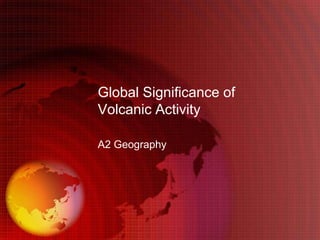
Lecture 2 global significance of volcanic activity
- 1. Global Significance of Volcanic Activity A2 Geography
- 2. Significance • Volcanic eruptions are major events broadcast worldwide. • Recent statistics suggest that about an average of 1000 people die each year from volcanic disasters a year • That‟s 1% of all geohazards • Not specifically a major significance then
- 3. So? • The average length of time between events (Known as „The return period‟) increases with the size (Magnitude) of the event • Historical records to date show a clear magnitude-frequency distribution of events. • Large numbers of small eruptions punctuated by rare but devastating „Great Eruptions‟ • As yet known though over VEI 8 even though it is clear these have occurred
- 4. Yeah but still? • Ok well not all eruptions have adverse affects on humans (Due to location or size) • Yet Major eruptions tend to still surprise human populations and have a massive potential to cause damage (Vulnerable) • Historically there are frequent small volcanoes with small losses but as yet no catastrophes.
- 5. Geography of Volcanoes • There are around 450 classified active volcanoes globally (They have erupted before in historic times) • Another 200+ sites which are capable of eruption (Active or dormant) • 1000‟s of dead or extinct posing no threat • Huge numbers of submarines sites not yet visible and presently pose no threat
- 6. Active and Dormant • They show two clear features: • Along the margins of tectonic plates (Inter- plate) where crust is either being formed at Constructive margins (Andean Volcanoes of Chile and Peru) • Above local hotspots within plates (Intra- plate) e.g. Hawaii where the earth‟s crust is thinner
- 7. Patterns of Behaviour • The distribution of volcanic hazards is fundamentally determined by magma composition. • 3 groups of eruptive behaviour can be identified:
- 8. Type Mineral Viscosity Cooling Characterisitcs Composition time Basic or Iron rich, Silica Low Slow Lava domes Basaltic poor Intermediate Magma is rich viscous Quicker Vents get blocked, (Andesitic) in Silica (Sticky) explosions occur, pyroclastic material is generated + Lava. Produce Stratified volcanoes Acid Magma is silica High Quickly Violent eruptions, (Rhyolitic) rich and iron unpredictable, lots of poor pyroclastic material produced Therefore it is the variations in magma composition that largely determines volcanic activity and thereby the hazard. This in turn is determined by crustal structure and composition
- 9. The Main types of Magma Comparison of three different Magma types Volcanic Rock Basalt Andesite Rhyolite Type Rock Description Black to Dark Grey Medium to dark Light coloured grey Volume of Earths 80% 10% 10% surface Silica Content 45-55% 55-65% 65-75% Temp 1,000 – 1,200 800 – 1000 600 – 900 Viscosity Low (Heated Ice Intermediate High (Toothpaste) cream) Gas Escape from Easy Intermediate Difficult magma Eruptive Style Peaceful Intermediate Explosive
- 10. Basalt Andesite Rhyolite
- 11. Volcanic Types • Oceanic crust is basic and produces basaltic volcanoes • “Active” Continental margins have magma produced from both oceanic and continental (Granitic) crust + subducted water and sediment therefore contains more silica and volatiles so becomes more violent and unpredictable • Continental Interiors have magma produced predominantly from continental crust and therefore produces acidic or Rhyolitic volcanoes
- 12. So what does all this mean? • Each volcano has its own hazard geography determined by structure, magma source, topographic form and climatic factors such as prevailing wind direction. • Each eruption is unique and can be different from near neighbours • The greatest threat is posed from the numerous „Active‟ “intermediate” volcanoes associated with active subduction zones, located where pop‟n growth has resulted in high density e.g. Indonesia and Parts of the Ring of Fire
- 13. References • Geology.com • Volcanoes by R.Tilling • Prof. David Jones Dept. Geography and the Environment LSE (Lecture) Further Reading: Web research for different lava flows as discussed in this lecture can be found >>HERE<<
